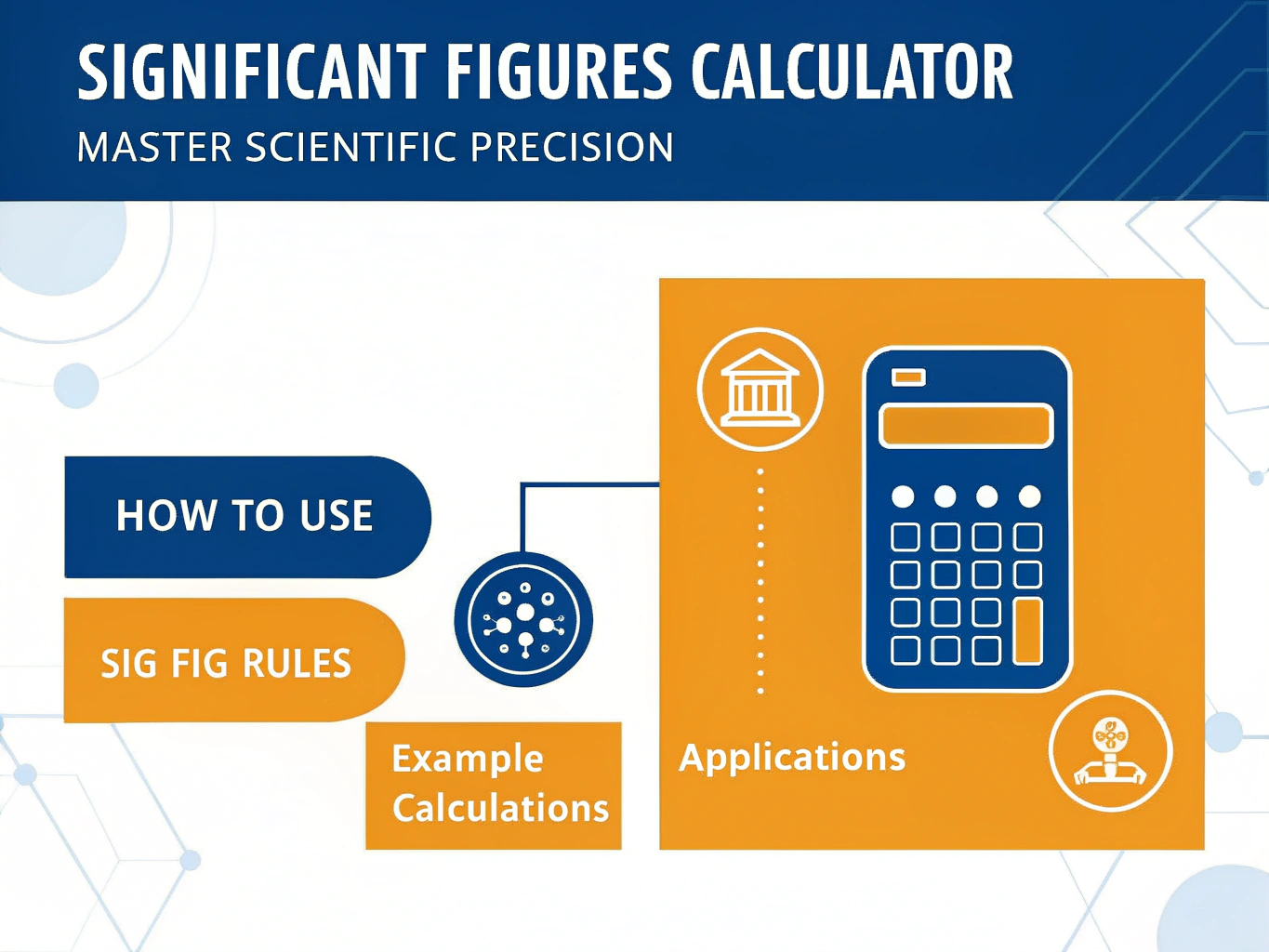Is this tool helpful?
How to Use the Significant Figures Calculator
Using this calculator is straightforward. Enter any number in the first field, specify how many significant figures you want, and click calculate to get your rounded result.
Enter Your Number
Type your number in the first input field. You can enter numbers in several formats:
- Standard decimal notation: 3.14159 or 0.000456
- Scientific notation: 1.23e-4 or 6.02e23
- Integers: 12345 or 987
- Negative numbers: -273.15 or -1.5e-3
For example, try entering 98765.4321 or 0.0007854 to see how the calculator handles different number types.
Choose Significant Figures
In the second field, enter how many significant figures you want in your final result. You can choose any number from 1 to 15. For the sample numbers above, try setting the significant figures to 3 for the first number and 2 for the second.
View Your Results
After clicking calculate, you’ll see a comprehensive results panel showing:
- Your original number
- The rounded number with your chosen significant figures
- Scientific notation representation
- How many significant figures your original number had
- Absolute and relative error from rounding
Understanding Significant Figures in Scientific Calculations
Significant figures represent the precision of a measured or calculated value. They tell you which digits in a number are meaningful and reliable. This concept is essential in science, engineering, and mathematics where precision matters.
What Are Significant Figures?
Significant figures are the digits in a number that carry meaningful information about its precision. They help communicate the accuracy of measurements and calculations. When you round a number to a specific number of significant figures, you’re indicating the level of precision appropriate for your context.
Why Use a Significant Figures Calculator?
Manual rounding to significant figures can be tricky and error-prone, especially with:
- Very large or very small numbers
- Numbers in scientific notation
- Complex calculations requiring consistent precision
- Laboratory data analysis
- Engineering measurements
This calculator eliminates guesswork and ensures accuracy in your scientific work.
Example Calculations and Results
Example 1: Rounding a Large Number
Input: 123456.789 with 4 significant figures
Results:
- Rounded number: 123500
- Scientific notation: 1.235 × 10⁵
- Original significant figures: 9
- Absolute error: 43.211
The calculator correctly rounds to 4 significant figures by identifying the fifth digit (5) and rounding up the fourth digit accordingly.
Example 2: Working with Small Decimals
Input: 0.0008765 with 2 significant figures
Results:
- Rounded number: 0.00088
- Scientific notation: 8.8 × 10⁻⁴
- Original significant figures: 4
- Relative error: 0.399%
Notice how the calculator handles leading zeros correctly – they don’t count as significant figures.
Example 3: Scientific Notation Input
Input: 6.02214076e23 with 3 significant figures
Results:
- Rounded number: 6.02 × 10²³
- Scientific notation: 6.02 × 10²³
- Original significant figures: 9
The calculator seamlessly processes scientific notation and maintains the appropriate format for very large numbers.
Rules for Counting Significant Figures
Understanding these rules helps you interpret the calculator’s results:
Always Significant
- Non-zero digits: All digits 1-9 are always significant
- Zeros between non-zero digits: 1005 has 4 significant figures
- Trailing zeros with decimal points: 25.00 has 4 significant figures
Never Significant
- Leading zeros: 0.0052 has only 2 significant figures (5 and 2)
- Trailing zeros without decimal points: 1200 typically has 2 significant figures
Context-Dependent
Trailing zeros in whole numbers can be ambiguous. Scientific notation removes this ambiguity – 1.200 × 10³ clearly shows 4 significant figures.
Applications in Different Fields
Laboratory Sciences
Chemists and biologists use significant figures to report experimental results accurately. When you measure 15.67 mL of a solution, those four significant figures indicate your measurement’s precision.
Engineering Calculations
Engineers round calculations to match the precision of their measurements. If your input measurements have 3 significant figures, your final answer should too.
Academic Research
Researchers use significant figures to maintain consistency across datasets and ensure their conclusions match their data’s precision.
Advanced Features and Error Analysis
Error Calculations
The calculator provides both absolute and relative error measurements:
- Absolute error: The actual difference between original and rounded values
- Relative error: The percentage difference, useful for comparing errors across different scales
Scientific Notation Conversion
The calculator automatically converts results to scientific notation when appropriate, making it easier to work with very large or very small numbers while maintaining clarity about significant figures.
Input Validation
Built-in validation ensures you enter valid numbers and reasonable significant figure counts, preventing calculation errors and providing helpful feedback for corrections.
Tips for Effective Use
Choose Appropriate Precision
Select the number of significant figures based on your measurement precision or calculation requirements. Don’t use more significant figures than your least precise measurement.
Consider Your Context
Different fields have different conventions. Laboratory work might require 3-4 significant figures, while engineering calculations might need 2-3.
Verify Your Results
Use the original significant figures display to confirm your input number was interpreted correctly, especially for numbers with trailing zeros.
Understand the Limitations
Remember that significant figures represent precision, not accuracy. A precisely measured wrong value is still wrong, regardless of how many significant figures you use.
Important Disclaimer
The calculations, results, and content provided by our tools are not guaranteed to be accurate, complete, or reliable. Users are responsible for verifying and interpreting the results. Our content and tools may contain errors, biases, or inconsistencies. Do not enter personal data, sensitive information, or personally identifiable information in our web forms or tools. Such data entry violates our terms of service and may result in unauthorized disclosure to third parties. We reserve the right to save inputs and outputs from our tools for the purposes of error debugging, bias identification, and performance improvement. External companies providing AI models used in our tools may also save and process data in accordance with their own policies. By using our tools, you consent to this data collection and processing. We reserve the right to limit the usage of our tools based on current usability factors.







